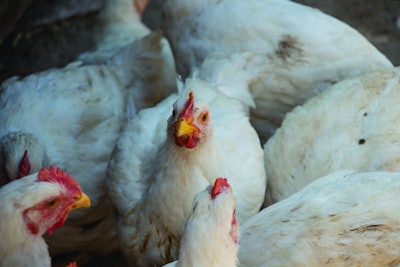
The European Food Safety Authority (EFSA) has published new scientific opinions on broiler and layer welfare to support ongoing revision of the EU’s revision of its animal welfare legislation.
The EU is in the process of updating its welfare rules to align with the latest scientific evidence, to broaden its scope and to make enforcement easier. A European Commission proposal is expected before the end of 2023.
EFSA’s Scientific Panel on Animal Health and Welfare (AHAW) has now made numerous recommendations which will be considered by the European Commission as part of the review process.
Opinion on broilers
Looking at broiler welfare, among those issues and remedies highlighted by the panel are that, where day old chicks are concerned, feed deprivation for longer than 48 hours will lead to "prolonged hunger," which is detrimental to their welfare. Among recommendations for day old chick husbandry is that dark brooders should be used which, the AHAW says, promote resting behavior and reduce sensory overstimulation.
The AHAW says that current broiler stocking densities in the EU impair welfare and that densities greater than 11 kg/m2 increase footpad dermatitis, reduce the ability to walk and impair comfort and exploratory behaviors.
Broilers must have friable litter to perform comfort, exploratory and foraging behaviors, and access to elevated platforms for broilers would reduce the risk of locomotor problems, predation stress and would promote resting behavior, the AHAW notes. Where ammonia is concerned, levels above 15 ppm impair welfare, it adds.
Turning to broiler breeders, the AHAW notes that feed and water restrictions cause prolonged hunger and thirst, and it goes on to say that further genetic selection for fast growth will exacerbate negative welfare consequences.
Housing grandparents, great grandparents and pure pedigree lines in individual barren cages results in isolation and handling stress; impaired exploratory, foraging and comfort behaviors; impaired resting; and movement restriction, the AHAW notes.
Mutilations, such as beak trimming, de-toeing, de-clawing and comb dubbing, while currently widely performed across the EU, could be avoided with appropriate management practices, the AHAW argues.

Broiler recommendations
The panel is recommending the following measures to improve broiler welfare:
- The growth rate of broilers should be limited to 50 g/day;
- Stocking densities should be substantially reduced from current levels to meet broilers’ behavioral needs;
- Birds must be provided with dry and friable litter, and new litter must be scattered after the second week of production;
- From two weeks of age, a covered veranda should be provided for broilers and broiler breeders;
- Access should be provided to an outdoor range with 70% vegetation;
- Elevated, accessible platforms with ramps should be provided for broiler chickens and perches provided for broiler breeders;
- All forms of mutilation in broiler breeders should be avoided;
- The use of cages, feed and water restrictions should be avoided in broiler breeders;
- Alternative methods for data collection should be developed, enabled by Precision Livestock Technologies;
- Ammonia concentration in the barn should be kept below 15 ppm;
- Minimum environmental lighting of 20 lux should be provided;
- Rather than transporting day old chicks, fertilized eggs should be transported to be hatched on farm;
- During incubation, eggshell temperature should not exceed 37.8 C; and
- On-farm mortality, wounded birds, carcass condemnation and footpad dermatitis should be monitored at the slaughterhouse.
Layer recommendations
The AHAW’s opinion on layers includes the following:
- Birds should be housed in cage-free systems;
- Protocols to measure welfare traits need to be defined, e.g. keel bone fractures and plumage condition, for all commercial hybrids to encourage further progress in genetic selection and to enable producers to choose strains with a reduced risk of bone and soft tissue lesions and skin damage;
- Producers must always provide friable litter, supplemented by the provision of new litter material and other enrichments that support comfort and exploratory behavior;
- All preventative measures against injurious pecking should be implemented to phase out beak trimming;
- Flocks should have easily accessible, elevated platforms and/or perches to allow simultaneous resting for all birds, and to enable birds to avoid each other;
- A covered veranda should be provided to reduce stocking density during the daytime when birds are most active and allow birds to choose between temperatures, light conditions and substrate quality:
- In climates where a covered veranda cannot be provided, additional space should be given;
- Harmonized assessment methods and scoring systems should be implemented for monitoring mortality and wounds, plumage damage, keel bone fractures and carcass rejection at slaughter. Such tools can be used to monitor welfare across farms in Europe, the AWAH says;
- Pullets should be reared with dark brooders to reduce fearfulness during rearing the subsequent laying period. They should be reared in a system that supports navigation skills; and
- In layer breeders, male aggression to females needs to be reduced, e.g. by reducing the proportion of males included in flocks (below 1:10), selecting male birds for reduced aggression and including a partition panel.


















